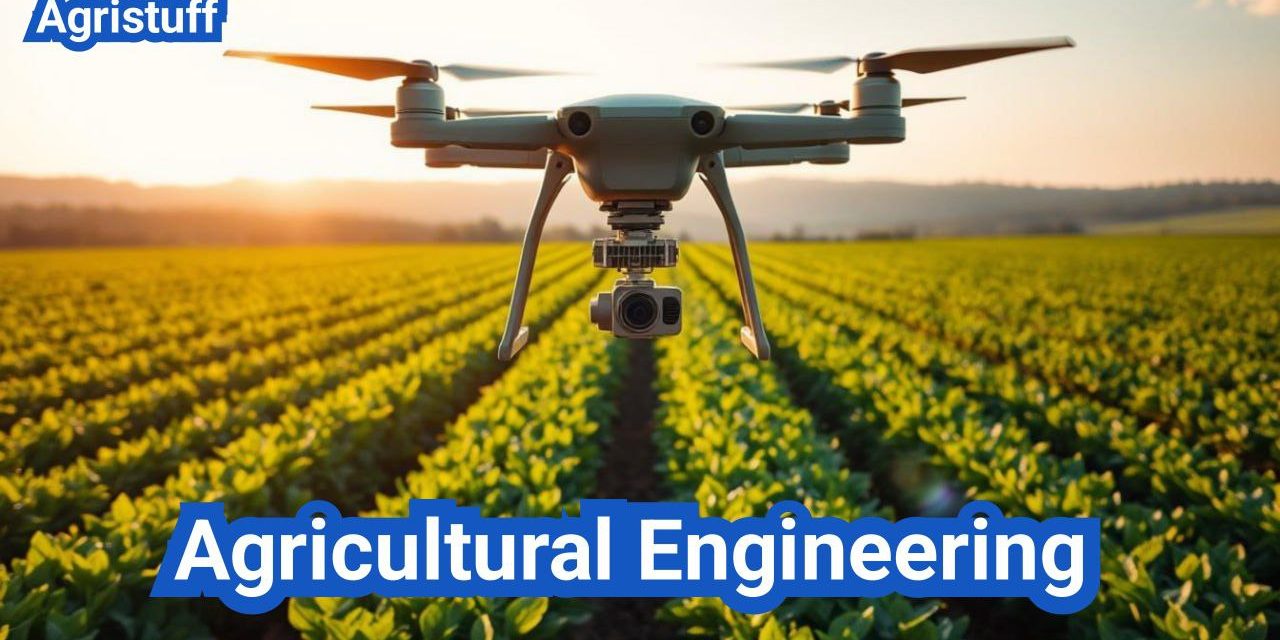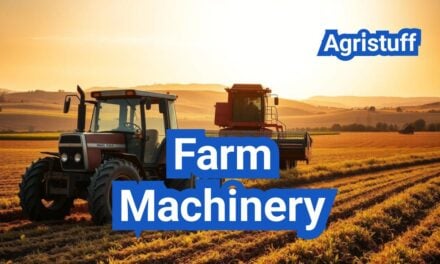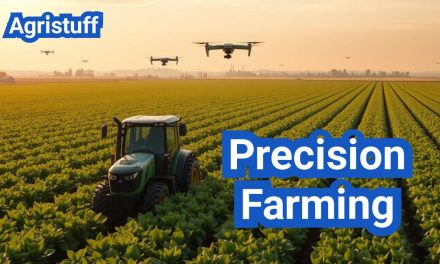The agricultural industry is on the cusp of a revolution, driven by technological advancements and the need for sustainable farming practices. Agricultural engineering plays a vital role in this transformation, enhancing productivity and efficiency in farming.
By leveraging innovations in precision agriculture and agricultural machinery, farmers can optimize crop yields, reduce waste, and promote environmental stewardship. This convergence of technology and agriculture is redefining the future of farming.
Key Takeaways
- The agricultural industry is undergoing a significant transformation driven by technological advancements.
- Agricultural engineering is crucial for improving productivity and sustainability in farming.
- Innovations in precision agriculture and agricultural machinery are key drivers of this change.
- These advancements enable farmers to optimize crop yields and reduce environmental impact.
- The integration of technology and agriculture is shaping the future of farming.
What Is Agricultural Engineering: Core Concepts and Principles
Agricultural engineering represents a crucial intersection of technology and agriculture, aiming to improve productivity and reduce environmental impact. The field encompasses a broad range of disciplines, combining engineering, biology, and agricultural science to develop innovative solutions.
Definition and Interdisciplinary Nature
Agricultural engineering is defined as the application of engineering principles to agricultural production and processing. It is an interdisciplinary field that draws on knowledge from engineering, biology, and agricultural sciences to develop efficient and sustainable farming practices. Biosystems engineers, in particular, play a vital role in this field by designing and implementing systems that integrate biological and engineering principles.
The interdisciplinary nature of agricultural engineering allows for a holistic approach to solving agricultural challenges. By combining insights from various fields, agricultural engineers can develop novel solutions that enhance productivity while minimizing environmental degradation.
Historical Evolution of Agricultural Engineering
Agricultural engineering has a rich history that dates back to the early 20th century when mechanization began to transform agricultural practices. Over the years, the field has evolved significantly, driven by advances in technology and changing agricultural needs.
The development of new machinery, irrigation systems, and other technologies has been pivotal in shaping the field. Today, agricultural engineering continues to evolve, incorporating cutting-edge technologies such as precision agriculture, automation, and biotechnology.
| Period | Key Developments | Impact on Agriculture |
|---|---|---|
| Early 20th Century | Mechanization of farming equipment | Increased productivity and efficiency |
| Mid-20th Century | Introduction of irrigation systems | Improved crop yields and water management |
| Late 20th Century | Adoption of precision agriculture | Enhanced precision in farming practices |
The Intersection of Agriculture and Engineering Sciences
The intersection of agriculture and engineering sciences is at the heart of agricultural engineering. By applying engineering principles to agricultural practices, agricultural engineers can develop innovative solutions that address pressing challenges such as food security, sustainability, and environmental conservation.
Through the integration of engineering and agricultural sciences, the field has seen significant advancements in areas such as machinery design, soil and water conservation, and post-harvest processing. These advancements have contributed to improved agricultural productivity and sustainability.
How to Understand the Key Branches of Agricultural Engineering

Understanding agricultural engineering requires a deep dive into its primary branches, which are transforming the agricultural landscape. Agricultural engineering is a multifaceted field that has evolved to address the complex needs of modern agriculture.
Machinery and Power Systems Engineering
Machinery and Power Systems Engineering is a critical branch that focuses on the design, development, and operation of machinery and power systems used in agriculture. This includes tractors, plows, and other equipment essential for farming. The goal is to improve efficiency, reduce labor, and enhance productivity.
Key aspects of this branch include the development of more efficient engines, transmission systems, and hydraulic systems. Innovations in machinery and power systems are crucial for advancing agricultural practices.
Soil and Water Engineering
Soil and Water Engineering is another vital branch that deals with the management of soil and water resources. It involves the design and implementation of irrigation systems, drainage systems, and soil conservation measures. This branch is essential for maintaining soil health and optimizing water use.
Effective soil and water conservation techniques are critical in preventing erosion, reducing water waste, and ensuring sustainable agricultural practices. This branch also explores new technologies for water harvesting and efficient irrigation systems.
Food and Bioprocess Engineering
Food and Bioprocess Engineering focuses on the processing, preservation, and packaging of agricultural products. This branch applies engineering principles to improve the quality and safety of food products. It involves the development of new processing technologies and equipment.
Advances in food and bioprocess engineering have led to improved food safety, reduced post-harvest losses, and enhanced nutritional value. This branch is crucial for meeting the global demand for safe and nutritious food.
Environmental Systems Engineering
Environmental Systems Engineering addresses the environmental impact of agricultural practices. It involves the development of systems and technologies that minimize environmental degradation while maintaining agricultural productivity. This includes waste management, pollution control, and climate change mitigation strategies.
Sustainable practices are at the heart of environmental systems engineering. By applying engineering principles to environmental challenges, this branch helps to create more sustainable agricultural systems.
How to Pursue a Career in Agricultural Engineering
To embark on a successful career in agricultural engineering, it’s crucial to identify your area of interest and align it with the right educational background. Agricultural engineering is a diverse field that encompasses various disciplines, including machinery and power systems, soil and water engineering, food and bioprocess engineering, and environmental systems engineering.
Identifying Your Area of Interest
The first step in pursuing a career in agricultural engineering is to identify your area of interest. This involves understanding the different branches within the field and determining which area aligns with your skills, interests, and career goals. For instance, if you’re passionate about machinery and technology, you might consider specializing in machinery and power systems engineering.
Educational Pathways and Requirements
Once you’ve identified your area of interest, the next step is to pursue the necessary education and training. Typically, a bachelor’s degree in agricultural engineering or a related field is required. Coursework should include subjects like mathematics, physics, biology, and engineering principles. Some positions may require advanced degrees, such as master’s or Ph.D.s, especially for roles in research and development or academia.
Key educational pathways include:
- Bachelor’s degree in Agricultural Engineering or related fields
- Master’s degree for advanced research and development roles
- Ph.D. for senior research positions or academia
Professional Certifications and Licensing
In addition to formal education, obtaining professional certifications and licenses can significantly enhance your career prospects. In the United States, for example, becoming a Professional Engineer (PE) is highly regarded and often required for certain positions. Certifications demonstrate expertise and commitment to the profession, making you a more competitive candidate in the job market.
The benefits of professional certifications include:
- Enhanced job prospects
- Demonstrated expertise and knowledge
- Increased credibility among employers and peers
Developing Essential Skills for Agricultural Engineers

To excel, agricultural engineers must possess a comprehensive set of skills that span technical knowledge and interpersonal abilities. The multifaceted nature of agricultural engineering demands a unique blend of competencies that enable professionals to design, develop, and implement innovative solutions in agriculture.
Technical Competencies
Agricultural engineers require a strong foundation in technical skills, including:
- Proficiency in computer-aided design (CAD) software for designing farm machinery and equipment.
- Knowledge of agricultural engineering technology, such as precision agriculture tools and automated farming systems.
- Understanding of biosystems engineering principles, including the application of engineering principles to biological systems.
Problem-Solving Methodologies
Effective problem-solving is critical for agricultural engineers, who must be able to analyze complex problems and develop practical solutions. This involves:
- Identifying and defining problems in agricultural production and processing.
- Applying engineering principles to develop innovative solutions.
- Evaluating the effectiveness of solutions and making necessary adjustments.
Communication and Collaboration Skills
Agricultural engineers must also possess excellent communication and collaboration skills to work effectively with farmers, researchers, and other stakeholders. Key skills include:
- The ability to communicate complex technical information to non-technical stakeholders.
- Collaboration with multidisciplinary teams to develop and implement agricultural projects.
- Negotiation and conflict resolution skills to manage project-related disputes.
By developing these essential skills, agricultural engineers can drive innovation and efficiency in agricultural practices, contributing to a more sustainable food system.
How to Design and Develop Farm Machinery and Equipment
The development of farm equipment is a complex process that involves assessing agricultural requirements and applying engineering solutions. Agricultural engineering plays a crucial role in this process, combining principles from engineering, biology, and agricultural sciences to create efficient and productive farm machinery.
Assessing Agricultural Needs and Requirements
Understanding the specific needs of agricultural operations is the first step in designing farm machinery. This involves analyzing the type of crops, soil conditions, and existing farming practices. By doing so, engineers can identify areas where machinery can improve efficiency and productivity.
- Identify the type of crops and their specific needs.
- Analyze soil conditions and their impact on machinery design.
- Examine existing farming practices to determine where improvements can be made.
Designing Process and Prototyping
Once the agricultural needs are assessed, the next step is to design the machinery. This involves creating detailed designs and prototypes that can be tested. The use of computer-aided design (CAD) software has become indispensable in this phase, allowing for precise and efficient design iterations.
- Create initial designs based on the assessed needs.
- Develop prototypes for testing and validation.
- Iterate designs based on feedback and test results.
Testing and Optimization Procedures
Testing is a critical phase in the development of farm machinery. It involves evaluating the performance of the machinery under various conditions to ensure it meets the required standards. Optimization may involve making adjustments to the design or materials used to improve durability and efficiency.
- Conduct performance tests under different conditions.
- Evaluate the machinery’s efficiency and productivity.
- Make necessary adjustments to optimize performance.
Case Studies of Successful Implementations
Several case studies illustrate the successful design and development of farm machinery. For instance, the introduction of precision agriculture technologies has significantly improved crop yields and reduced waste. Another example is the development of automated farming equipment, which has enhanced efficiency and reduced labor costs.
These examples demonstrate the potential of agricultural engineering to transform farming practices through innovative machinery design and development.
Implementing Precision Agriculture Technologies on Farms

The integration of precision agriculture technologies on farms is leading to significant improvements in agricultural productivity and sustainability. Precision agriculture involves the use of advanced technologies such as GPS, GIS, remote sensing, and variable rate application to optimize crop yields and reduce waste.
Setting Up GPS and GIS Systems
One of the foundational elements of precision agriculture is the setup of GPS and GIS systems. GPS (Global Positioning System) provides accurate location data, while GIS (Geographic Information System) allows for the analysis and visualization of spatial data. Together, they enable farmers to make informed decisions about planting, irrigation, and harvesting.
Key steps in setting up GPS and GIS systems include:
- Installing GPS receivers on farm equipment
- Creating detailed maps of the farm using GIS software
- Integrating GPS and GIS data to guide farming operations
Deploying Remote Sensing Technologies
Remote sensing technologies, including satellite imagery and drones, are used to gather data on crop health, growth, and development. This information is crucial for identifying issues early and taking corrective action.
The benefits of remote sensing include:
- Early detection of crop stress and disease
- Improved crop monitoring and management
- Enhanced decision-making capabilities
Implementing Variable Rate Application
Variable rate application (VRA) involves applying inputs such as fertilizers, pesticides, and irrigation water at varying rates across the farm, based on the specific needs of different areas. This approach helps in optimizing resource use and reducing environmental impact.
VRA technologies include:
- Precision irrigation systems
- Variable rate fertilizer applicators
- Automated control systems for precision application
Data Management and Analysis
Effective data management and analysis are critical to the success of precision agriculture. Farmers must collect, store, and analyze large amounts of data from various sources, including GPS, GIS, and remote sensing technologies.
Key aspects of data management include:
- Data integration and storage solutions
- Advanced data analytics tools
- Decision support systems for farmers
Smart Farming Technologies: Selection and Implementation Guide

With the advent of smart farming, the agricultural industry is witnessing a significant shift towards precision agriculture. Smart farming technologies are being increasingly adopted to enhance efficiency, productivity, and sustainability in farming practices.
Evaluating IoT Devices for Agricultural Use
The Internet of Things (IoT) plays a crucial role in smart farming by enabling the use of connected devices to monitor and manage various agricultural processes. When evaluating IoT devices, farmers should consider factors such as compatibility, data accuracy, and ease of use.
Key considerations for IoT devices include:
- Data collection and analytics capabilities
- Connectivity options (e.g., Wi-Fi, Bluetooth, cellular)
- Power supply and energy efficiency
- Durability and weather resistance
Installing Sensor Networks
Sensor networks are a vital component of smart farming, providing real-time data on soil moisture, temperature, and crop health. When installing sensor networks, it is essential to ensure proper placement and calibration to obtain accurate data.
Best practices for sensor network installation:
- Determine the optimal sensor placement based on crop type and field layout
- Calibrate sensors according to manufacturer instructions
- Ensure reliable data transmission and storage
Implementing Automation and Robotics
Automation and robotics are transforming farming practices by increasing efficiency and reducing labor costs. Farmers can implement automation technologies such as drones, autonomous tractors, and robotic harvesters to streamline their operations.
Benefits of automation and robotics:
- Increased precision and accuracy
- Reduced labor costs and improved worker safety
- Enhanced crop monitoring and management
Creating Decision Support Systems
Decision support systems (DSS) are software tools that help farmers make informed decisions by analyzing data from various sources, including IoT devices and sensor networks. A well-designed DSS can optimize crop yields, reduce waste, and improve resource allocation.
Key components of a DSS:
- Data integration and analytics
- Predictive modeling and forecasting
- User-friendly interface and visualization tools
Designing Effective Irrigation Systems for Different Environments
Effective irrigation systems are the backbone of sustainable agriculture, supporting water conservation and soil health. As the global population continues to grow, the demand for efficient irrigation technologies becomes increasingly important.
Conducting Water Requirement Assessments
Conducting thorough water requirement assessments is the first step in designing an effective irrigation system. This involves understanding the specific water needs of different crops, soil types, and climatic conditions. Agricultural engineers use various tools and techniques, including evapotranspiration (ET) data and soil moisture monitoring, to determine the optimal water application rates.
For instance, a study on irrigation management in cornfields highlighted the importance of ET data in reducing water waste. By accurately measuring ET, farmers can adjust their irrigation schedules to match the crop’s water needs, thereby conserving water.
Selecting Appropriate Irrigation Methods
The selection of an appropriate irrigation method depends on several factors, including crop type, soil characteristics, and local climate conditions. Common irrigation methods include drip irrigation, sprinkler irrigation, and surface irrigation. Drip irrigation, for example, is highly efficient as it delivers water directly to the root zone, minimizing evaporation and runoff.
| Irrigation Method | Water Efficiency | Suitability |
|---|---|---|
| Drip Irrigation | High | Crops requiring precise water application |
| Sprinkler Irrigation | Medium to High | Large fields, uniform water distribution |
| Surface Irrigation | Low to Medium | Flat lands, flood irrigation |
Implementing Water Conservation Strategies
Implementing water conservation strategies is crucial for sustainable irrigation practices. This can include using mulches to reduce soil evaporation, implementing rainwater harvesting systems, and adopting deficit irrigation practices. Deficit irrigation, for instance, involves applying less water than the crop’s full requirement, which can lead to significant water savings without substantially impacting yields.
“The future of irrigation lies in precision agriculture and smart irrigation technologies that can significantly reduce water usage while maintaining or even increasing crop yields.”
— Dr. John Smith, Agricultural Engineer
As shown in the table above, different irrigation methods offer varying levels of water efficiency and suitability for different crops and conditions. By carefully selecting and implementing the appropriate irrigation method, farmers can significantly reduce their water usage.
In conclusion, designing effective irrigation systems requires a comprehensive approach that includes water requirement assessments, appropriate irrigation method selection, and the implementation of water conservation strategies. By adopting these practices, farmers and agricultural engineers can contribute to more sustainable agricultural practices.
Soil and Water Conservation Engineering Techniques

Soil erosion and water loss can be significantly mitigated through advanced conservation engineering techniques. These methods are crucial for maintaining soil health, reducing sedimentation in water bodies, and ensuring sustainable agricultural productivity.
Implementing Erosion Control Methods
Erosion control is a critical aspect of soil and water conservation. Techniques such as terracing, contour farming, and the use of cover crops help reduce soil erosion by minimizing the impact of rainfall and runoff. Terracing involves creating flat plots of land on slopes to reduce erosion and improve water retention.
Contour farming is another effective method where crops are planted across a slope following its elevation contour lines. This technique helps in reducing soil erosion and retaining water.
Designing Effective Drainage Systems
Effective drainage systems are essential for managing water resources and preventing waterlogged soil conditions. These systems help in removing excess water from the soil surface and subsurface, thereby improving soil aeration and reducing the risk of waterborne diseases.
- Drainage design should consider factors like soil type, slope, and climate.
- Surface and subsurface drainage systems should be integrated for optimal water management.
Developing Watershed Management Plans
Watershed management involves coordinating the use of land and water resources within a watershed. It includes measures to control erosion, manage water flow, and improve water quality. Watershed management plans are developed based on a thorough assessment of the watershed’s hydrological and ecological characteristics.
| Watershed Management Techniques | Benefits |
|---|---|
| Erosion Control Measures | Reduced Soil Loss, Improved Water Quality |
| Flood Control Structures | Protection from Flood Damage, Enhanced Water Retention |
| Water Conservation Practices | Improved Water Availability, Reduced Water Waste |
Monitoring and Maintenance Procedures
Regular monitoring and maintenance are crucial for the effectiveness of soil and water conservation measures. This includes inspecting drainage systems, assessing the condition of erosion control structures, and adjusting watershed management plans as necessary.
Developing Climate-Smart Agricultural Solutions

As climate change continues to impact agricultural productivity, the need for climate-smart agricultural solutions becomes increasingly important. Climate-smart agriculture involves a set of practices and technologies aimed at enhancing agricultural productivity, improving livelihoods, and building resilience to climate change.
Conducting Climate Impact Assessments
The first step in developing climate-smart agricultural solutions is conducting thorough climate impact assessments. This involves analyzing the potential impacts of climate change on agricultural systems, including temperature and precipitation patterns, extreme weather events, and changing pest and disease dynamics.
According to the Food and Agriculture Organization (FAO), “climate-smart agriculture aims to achieve food security and broader development goals in the face of climate change.”
Implementing Adaptation Strategies
Once the climate impacts are assessed, the next step is to implement adaptation strategies. These strategies may include practices such as conservation agriculture, agroforestry, and the use of climate-resilient crop and animal varieties.
- Conservation agriculture
- Agroforestry
- Climate-resilient crop and animal varieties
As noted by
“The adoption of climate-resilient practices can significantly enhance the resilience of agricultural systems to climate change.”
Deploying Mitigation Technologies
In addition to adaptation strategies, deploying mitigation technologies is crucial for reducing greenhouse gas emissions from agricultural activities. This can include practices such as precision agriculture, renewable energy integration, and soil carbon sequestration.
| Mitigation Technology | Description | Benefits |
|---|---|---|
| Precision Agriculture | Use of technology to optimize crop yields and reduce inputs | Reduced emissions, improved efficiency |
| Renewable Energy Integration | Use of solar, wind, and other renewable energy sources | Reduced dependence on fossil fuels, lower emissions |
Measuring and Verifying Results
Finally, measuring and verifying the results of climate-smart agricultural practices is essential for ensuring their effectiveness and identifying areas for improvement. This involves monitoring indicators such as greenhouse gas emissions, soil health, and crop productivity.
By adopting a comprehensive approach to climate-smart agriculture, farmers and agricultural practitioners can enhance productivity, build resilience, and contribute to a more sustainable food system.
Post-Harvest Technology: Engineering Solutions for Food Preservation

Advances in post-harvest technology have transformed the way agricultural products are handled, stored, and processed. Effective post-harvest handling is crucial in minimizing losses and maximizing the value of agricultural products. This section explores the engineering solutions that are revolutionizing food preservation.
Designing Storage Facilities
Proper storage is essential for maintaining the quality of agricultural produce. Storage facilities must be designed to protect products from environmental factors such as moisture, temperature, and pests. Modern storage facilities incorporate advanced technologies like climate control and humidity management to create optimal storage conditions.
The design of storage facilities also involves considerations for accessibility, safety, and efficiency. For instance, the layout should facilitate easy loading and unloading of products, and the structure should be durable to withstand various environmental conditions.
Selecting Processing Equipment
The selection of appropriate processing equipment is vital for efficient post-harvest handling. This equipment ranges from cleaning and sorting machines to packaging machinery. The choice of equipment depends on the type of produce, the scale of operation, and the desired level of automation.
Modern processing equipment is designed to minimize damage to products, reduce labor costs, and enhance productivity. For example, optical sorting machines can accurately sort produce based on quality and size, significantly improving the efficiency of the processing line.
Implementing Quality Preservation Techniques
Quality preservation techniques are critical in maintaining the freshness and nutritional value of agricultural products. Techniques such as controlled atmosphere storage, modified atmosphere packaging, and cold storage are commonly used to extend the shelf life of perishable products.
These techniques work by controlling factors that contribute to spoilage, such as oxygen levels, temperature, and humidity. For instance, controlled atmosphere storage involves adjusting the levels of oxygen and carbon dioxide to slow down the ripening process of fruits and vegetables.
Reducing Post-Harvest Losses
Post-harvest losses are a significant challenge in the agricultural sector, resulting in economic losses and food insecurity. Engineering solutions play a crucial role in reducing these losses through improved handling, storage, and processing practices.
Strategies for reducing post-harvest losses include the adoption of appropriate technology, training for farmers and handlers, and infrastructure development. For example, the use of gentle handling equipment can reduce mechanical damage to produce, while improved storage facilities can minimize losses due to spoilage.
Integrating Renewable Energy Systems in Agricultural Operations

The integration of renewable energy systems is revolutionizing agricultural operations by providing sustainable and efficient energy solutions. As the agricultural sector continues to evolve, the adoption of renewable energy sources is becoming increasingly crucial for reducing environmental impact and improving operational efficiency.
Assessing Energy Needs and Resources
Before integrating renewable energy systems, it’s essential to assess the energy needs and resources available on the farm or agricultural operation. This involves evaluating current energy consumption patterns, identifying areas of inefficiency, and determining the potential for renewable energy generation. Conducting an energy audit is a critical step in this process, as it helps in understanding the energy demand and supply dynamics.
Farmers and agricultural engineers must consider factors such as land availability, climate, and existing infrastructure when assessing the feasibility of different renewable energy sources. For instance, solar energy might be more suitable for regions with high solar irradiance, while wind energy could be more appropriate for areas with consistent wind patterns.
Installing Solar Applications for Farms
Solar energy is one of the most accessible forms of renewable energy for agricultural operations. Installing solar panels can provide a reliable source of power for irrigation systems, farm equipment, and other energy needs. Solar photovoltaic (PV) systems are particularly popular due to their scalability and ease of installation.
When installing solar applications, it’s crucial to consider factors such as panel orientation, tilt angle, and shading to maximize energy production. Additionally, integrating energy storage solutions, such as batteries, can help stabilize the energy supply during periods of low sunlight.
Implementing Wind and Biomass Energy Systems
Wind and biomass energy systems offer alternative renewable energy solutions for agricultural operations. Wind turbines can be installed on farms to generate electricity, particularly in areas with suitable wind speeds. Biomass energy, derived from organic materials such as crop residues and manure, can be used to produce heat or electricity.
Implementing these systems requires careful planning and assessment of the available resources. For biomass energy, considerations include the availability of feedstock, conversion technology, and the potential environmental impacts.
Monitoring Performance and Efficiency
Once renewable energy systems are installed, monitoring their performance and efficiency is vital to ensure they operate as intended. This involves tracking energy production, identifying any issues or inefficiencies, and performing regular maintenance.
Advanced monitoring systems and data analytics can help optimize the performance of renewable energy systems. By leveraging these technologies, farmers and agricultural engineers can make data-driven decisions to improve energy efficiency and reduce operational costs.
Sustainable Agriculture Engineering Practices

Agricultural engineering is embracing sustainability to reduce environmental impact and enhance productivity. This shift is crucial as the world grapples with the challenges of climate change, population growth, and environmental degradation.
Implementing Resource Conservation Approaches
Resource conservation is a cornerstone of sustainable agriculture engineering. This involves the efficient use of water, soil, and energy resources. Techniques such as drip irrigation and precision agriculture enable farmers to conserve water while maintaining or increasing crop yields. Soil conservation methods, including no-till or reduced-till farming, help preserve soil health and reduce erosion.
Developing Waste Management and Recycling Systems
Effective waste management and recycling are critical components of sustainable agricultural practices. Agricultural waste can be recycled into valuable products such as biofertilizers, animal feed, and energy through anaerobic digestion. Implementing recycling programs on farms not only reduces waste but also creates additional revenue streams for farmers.
Reducing Environmental Impact
Sustainable agriculture engineering practices aim to minimize the environmental footprint of farming activities. This includes reducing greenhouse gas emissions through the use of renewable energy sources and efficient machinery. Integrated pest management (IPM) strategies minimize the use of chemical pesticides, protecting biodiversity and ecosystem services.
Measuring Sustainability Metrics
To ensure the effectiveness of sustainable agriculture engineering practices, it’s essential to measure their impact. Key sustainability metrics include water usage efficiency, soil health indicators, and energy consumption. Regular monitoring and assessment enable farmers and agricultural engineers to identify areas for improvement and implement data-driven decisions.
By adopting these sustainable agriculture engineering practices, the agricultural sector can contribute significantly to environmental conservation while ensuring food security for future generations.
Biosystems and Agricultural Engineering: Integration and Applications
By integrating biosystems and agricultural engineering, we can develop more effective and sustainable agricultural practices. This integration involves working with biological systems, implementing bioprocessing applications, and applying ecological engineering approaches to enhance productivity and reduce environmental impact.
Working with Biological Systems in Agriculture
Biosystems engineering in agriculture focuses on understanding and manipulating biological systems to improve crop yields and quality. This involves the application of engineering principles to biological systems, including plants, animals, and microorganisms.
Key aspects include genetic engineering, biotechnology, and the development of new agricultural practices that enhance sustainability.
Implementing Bioprocessing Applications
Bioprocessing applications in agriculture involve the use of biological systems to produce food, feed, and other products. This includes fermentation processes, biofuel production, and the development of new products from agricultural biomass.
Bioprocessing enhances the value of agricultural products and contributes to a more sustainable agricultural economy.
Applying Ecological Engineering Approaches
Ecological engineering approaches in agriculture aim to minimize environmental impact by designing and implementing systems that work in harmony with natural ecosystems. This includes practices such as conservation tillage, cover cropping, and the restoration of wetlands.
These approaches not only reduce environmental degradation but also enhance biodiversity and ecosystem services.
Case Studies of Successful Integration
Several case studies demonstrate the successful integration of biosystems and agricultural engineering. For example, the use of precision agriculture technologies, which combine GPS, GIS, and remote sensing to optimize crop management, has significantly improved yields and reduced waste.
- Precision agriculture technologies
- Bioprocessing for biofuel production
- Ecological engineering for wetland restoration
These examples highlight the potential of integrating biosystems and agricultural engineering to achieve more sustainable and productive agricultural systems.
Top Agricultural Engineering Companies and Employment Opportunities
The landscape of agricultural engineering is transforming, driven by pioneering companies that are shaping the future of farming and creating employment opportunities.
Major Employers and Industry Leaders
Several top companies are leading the way in agricultural engineering, offering a range of employment opportunities. Some of the major employers include:
- John Deere, known for its innovative farming equipment and technology
- CNH Industrial, a global leader in agricultural machinery
- AGCO Corporation, manufacturer of agricultural equipment and solutions
- Bayer CropScience, a prominent player in crop protection and agricultural biotechnology
These companies are not only driving innovation but also providing numerous job opportunities in areas such as engineering, research, and sales.
Research and Development Positions
Research and development (R&D) is a critical aspect of agricultural engineering, driving innovation and improving farming practices. R&D positions are available in various areas, including:
- Precision agriculture and data analysis
- Development of new farming equipment and technology
- Crop improvement through genetic research and biotechnology
Companies and research institutions are seeking professionals with expertise in these areas to develop sustainable and efficient farming solutions.
Consulting and Entrepreneurship Paths
Agricultural engineering also offers opportunities in consulting and entrepreneurship. Professionals can start their own consulting firms, providing expertise to farmers and agricultural businesses. Alternatively, they can develop innovative products or services, creating new businesses in the agricultural sector.
Some successful examples include:
- Precision farming consultants helping farmers optimize crop yields
- Entrepreneurs developing and marketing new agricultural technologies
Salary Expectations and Career Growth
Salary expectations in agricultural engineering vary based on factors such as location, experience, and specific job role. However, here are some general salary ranges for different positions:
| Job Role | Average Salary Range |
|---|---|
| Agricultural Engineer | $65,000 – $100,000 per year |
| R&D Specialist | $70,000 – $120,000 per year |
| Consultant | $60,000 – $150,000 per year |
Career growth opportunities are abundant, with potential for advancement to senior roles or leadership positions within companies, or the possibility of starting one’s own business.
The Future of Agricultural Engineering
Agricultural engineering is poised to revolutionize the way we produce and manage food, with a promising future that is both sustainable and productive. As the global population continues to grow, the demand for efficient and environmentally friendly farming practices is becoming increasingly important.
The future of agricultural engineering is closely tied to advancements in sustainable agriculture and precision agriculture. These fields are driving innovation, enabling farmers to optimize crop yields, reduce waste, and minimize environmental impact. By leveraging technologies such as GPS, GIS, and remote sensing, agricultural engineers can develop solutions that improve resource allocation and reduce the ecological footprint of farming.
The potential of agricultural engineering to improve productivity and sustainability is vast. As the industry continues to evolve, we can expect to see new technologies and methodologies emerge, further enhancing the efficiency and effectiveness of agricultural practices. By embracing these advancements, we can create a more food-secure future, where agricultural engineering plays a vital role in meeting the world’s growing needs.
FAQ
What is agricultural engineering?
Agricultural engineering is a discipline that combines principles from engineering, biology, and agricultural sciences to develop innovative solutions for agricultural production, processing, and management.
What does an agricultural engineer do?
Agricultural engineers design, develop, and implement systems, equipment, and technologies to improve agricultural productivity, efficiency, and sustainability, including farm machinery, irrigation systems, and post-harvest processing facilities.
What are the key branches of agricultural engineering?
The main branches of agricultural engineering include machinery and power systems engineering, soil and water engineering, food and bioprocess engineering, and environmental systems engineering, each focusing on different aspects of agricultural production and management.
What skills are required for agricultural engineers?
Agricultural engineers need a combination of technical competencies, problem-solving methodologies, and soft skills, including communication, collaboration, and project management skills, to effectively design and implement agricultural engineering solutions.
How do I pursue a career in agricultural engineering?
To pursue a career in agricultural engineering, you typically need to earn a bachelor’s degree in agricultural engineering or a related field, gain practical experience through internships or research projects, and consider obtaining professional certifications or a graduate degree for advanced roles.
What is precision agriculture, and how is it implemented?
Precision agriculture involves using advanced technologies, such as GPS, GIS, and remote sensing, to optimize crop management, reduce waste, and improve yields, and is implemented through a combination of hardware, software, and data analysis.
What are smart farming technologies, and how are they selected and implemented?
Smart farming technologies include IoT devices, sensor networks, automation, and robotics, which are selected based on specific agricultural needs and implemented to improve efficiency, productivity, and decision-making on farms.
How do agricultural engineers design effective irrigation systems?
Agricultural engineers design effective irrigation systems by conducting water requirement assessments, selecting appropriate irrigation methods, and implementing water conservation strategies to optimize water use and reduce waste.
What is climate-smart agriculture, and how is it developed?
Climate-smart agriculture involves developing and implementing agricultural practices and technologies that help farmers adapt to and mitigate the impacts of climate change, through climate impact assessments, adaptation strategies, and mitigation technologies.
How can agricultural engineers contribute to sustainable agriculture?
Agricultural engineers can contribute to sustainable agriculture by implementing resource conservation approaches, developing waste management and recycling systems, reducing environmental impact, and measuring sustainability metrics to promote eco-friendly practices.
What are the employment opportunities and salary expectations for agricultural engineers?
Agricultural engineers can find employment in various sectors, including research and development, consulting, and industry, with salary expectations varying based on factors such as location, experience, and specific job roles, but generally offering competitive compensation and career growth opportunities.
Conclusion of: Agricultural Engineering
Agricultural engineering is a vital discipline that blends the principles of engineering with agricultural production and processing. As global populations rise and climate challenges intensify, agricultural engineering plays a crucial role in ensuring sustainable food production, efficient resource use, and environmental conservation. This article explores every aspect of agricultural engineering, from its definition and history to its modern-day applications and technologies.
What Is Agricultural Engineering?
Agricultural engineering is the branch of engineering that applies scientific and technological innovations to agriculture. It includes the design and development of farming equipment, irrigation systems, machinery, structures, and processes that enhance agricultural productivity and sustainability. Learn more
The History of Agricultural Engineering
The roots of agricultural engineering date back to ancient civilizations, where basic tools and irrigation methods were developed. The Industrial Revolution marked a turning point, introducing mechanized tools like the steam-powered tractor. In the 20th century, agricultural engineering evolved into a formal discipline, integrating with biology, environmental science, and information technology. Explore historical developments
Key Areas of Agricultural Engineering
Agricultural engineering is a multidisciplinary field. Key areas include:
- Farm machinery and power: designing tractors, harvesters, and other equipment
- Soil and water conservation: irrigation and drainage systems
- Structures and environment: barns, greenhouses, and livestock housing
- Food and bioprocess engineering: post-harvest technology and food safety
Role of Agricultural Engineers
Agricultural engineers work on-site at farms, in research labs, or for government agencies. They analyze agricultural problems and develop equipment or systems to solve them. Their work helps farmers reduce costs, conserve resources, and comply with environmental regulations. See job profiles
Technologies in Agricultural Engineering
Modern agricultural engineering integrates advanced technologies such as:
- Precision agriculture: GPS and remote sensing for targeted farming
- Drones: monitoring crop health and spraying
- Automation and robotics: driverless tractors and robotic harvesters
- IoT: smart sensors for soil and weather monitoring
Importance of Agricultural Engineering in Sustainability
Agricultural engineering helps balance food production with environmental protection. Engineers design efficient irrigation systems that reduce water waste and develop eco-friendly pest control methods. Their innovations contribute to sustainable farming practices globally. Read sustainability insights
Challenges Faced by Agricultural Engineers
Agricultural engineers encounter numerous challenges:
- Climate change: designing systems adaptable to extreme weather
- Resource scarcity: optimizing use of water, energy, and soil
- Technological integration: ensuring user-friendly and cost-effective solutions
- Policy and regulation: meeting environmental and safety standards
Understand engineering challenges
Education and Career Path in Agricultural Engineering
A career in agricultural engineering typically requires a bachelor’s degree in agricultural or biological engineering. Advanced positions may need a master’s or PhD. Key coursework includes fluid mechanics, environmental engineering, and systems design. Graduates find jobs in farming equipment firms, food processing companies, research institutions, and government agencies. Check academic programs
Innovations Shaping the Future of Agricultural Engineering
Innovations like vertical farming, renewable energy integration, and genetic engineering are transforming the agricultural landscape. Agricultural engineers play a crucial role in designing systems that make these innovations practical and scalable. Explore future trends
Agricultural Engineering and Climate Resilience
Agricultural engineers contribute to climate resilience by creating adaptive systems such as flood-resistant irrigation, weather-informed planting schedules, and sustainable energy sources for rural farms. These developments help farmers mitigate climate risks and ensure long-term productivity. Learn about climate resilience
Final Thought
Agricultural engineering stands at the intersection of science, technology, and sustainability. It empowers farmers, enhances food security, and protects the environment. As agriculture faces mounting challenges, the role of agricultural engineering becomes even more critical. This field is not just about machines; it’s about crafting solutions for a better, more sustainable future.










